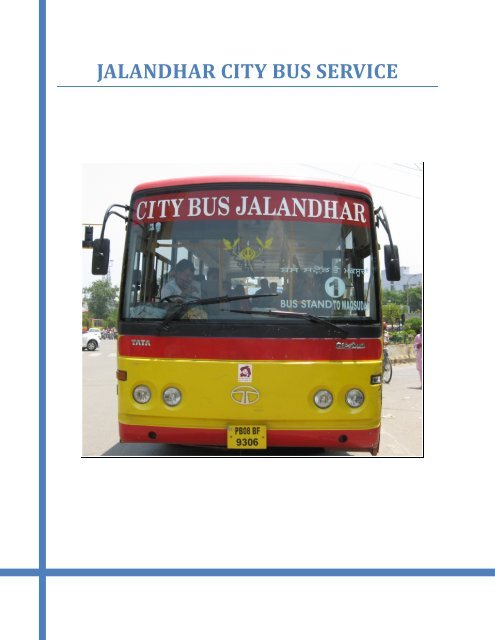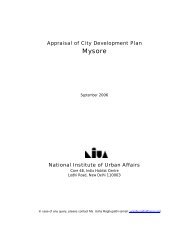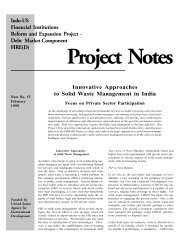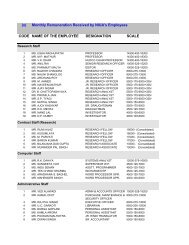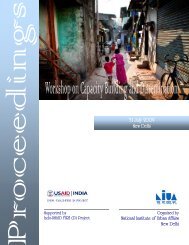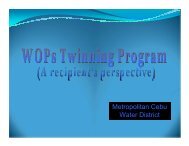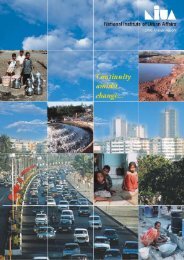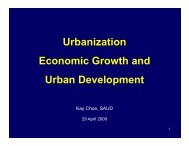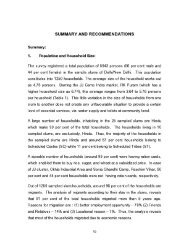JALANDHAR CITY BUS SERVICE - National Institute of Urban Affairs
JALANDHAR CITY BUS SERVICE - National Institute of Urban Affairs
JALANDHAR CITY BUS SERVICE - National Institute of Urban Affairs
Create successful ePaper yourself
Turn your PDF publications into a flip-book with our unique Google optimized e-Paper software.
<strong>Urban</strong> Transport Initiatives in India: Best Practices in PPP• SPV may have strict monitoring on the buses which are operating on uneconomicroutes.4.3.6 Expected Outcome <strong>of</strong> the Initiatives• Huge demand from different location to start City Bus;• Approximately 8000 passengers to travel in a day; and• Satisfied passengers with quality service.Figure 4.5: Running with Full Occupancy4.3.7 Role and Activities <strong>of</strong> the Partner• Department <strong>of</strong> Local Govt., Punjab and Punjab Infrastructure Development Board,Punjab introduced this City Bus Project;• IL&FS is the project consultant for implementation <strong>of</strong> this project;• Municipal Corporation, Jalandhar providing space for City Bus Depot and BusQueue Shelters in Jalandhar city at very nominal rates on lease basis; and<strong>National</strong> <strong>Institute</strong> <strong>of</strong> <strong>Urban</strong> <strong>Affairs</strong>81
<strong>Urban</strong> Transport Initiatives in India: Best Practices in PPP• JCTSL in execution <strong>of</strong> the project under the guidance <strong>of</strong> Municipal Corporation,Jalandhar.4.3.8 Important Stakeholders Involved and Communication / Networking Procedure forthe Project:Bus Operators:• M/s Poornima Travels, Udupi, Karnataka;• M/s Sri Anantha Padmanabha Motors, Udupi, Karnataka;• M/s R.K. Travels, Mangalore, Karnataka; and• M/s Nava Ganesh Logistics, Mangalore, Karnataka.Bus Queue Shelters (on BOT basis):• M/s Laqshya Outdoors Pvt. Ltd. (A division <strong>of</strong> M/s Laqshya Media Pvt. Ltd.),Mumbai.Electronic Ticketing Machine:• M/s R-Square Solution, Pune.Monthly Bus Pass:• M/s Ambica Cards, Amritsar.Global Positioning System:• M/s HCL Infosys.4.4 Factors <strong>of</strong> Success• Comfortable buses having 2 x 2 seating facility with a total capacity <strong>of</strong> 84passengers [44 seating and 40 standing (Approx.)].• Low fare rates for quality service to the passengers.<strong>National</strong> <strong>Institute</strong> <strong>of</strong> <strong>Urban</strong> <strong>Affairs</strong>82
<strong>Urban</strong> Transport Initiatives in India: Best Practices in PPP4.5 Budgetary Implications and Sustainability4.5.1 Total Cost <strong>of</strong> the Project` 10 million (approx.)4.5.2 Financial Partners InvolvedTwo Financial Partners <strong>of</strong> Jalandhar City Transport Services Limited:• Municipal Corporation, Jalandhar.• Punjab Infrastructure Development Board, Punjab.4.5.3 Source <strong>of</strong> Finance for Sustainability <strong>of</strong> the ProjectCapital investment <strong>of</strong> JCTSL:• 60% capital invested by Municipal Corporation, Jalandhar.• 40% capital invested by Punjab Infrastructure Development Board, Punjab.Bus Depot:• Constructed and maintained by Jalandhar City Transport Services limited.Buses:• Investment in Buses by four private operators.• Bus Queue Shelters:• Bus Queue Shelters constructed on BOT basis.4.6 Impact <strong>of</strong> the InitiativesThe study team interacted with the commuters who were traveling by these buses. It wasfound that the commuters, who were using Intermediate Public Transport (IPT) modesearlier, have switched over to these buses. The commuters were found satisfied with theservices <strong>of</strong> these buses. They mentioned that these buses are time efficient but the frequencies<strong>National</strong> <strong>Institute</strong> <strong>of</strong> <strong>Urban</strong> <strong>Affairs</strong>83
<strong>Urban</strong> Transport Initiatives in India: Best Practices in PPP<strong>of</strong> these buses are very low. They usually get the bus after half an hour. They have requestedthe authority to increase the frequencies <strong>of</strong> these buses so that their waiting time for city buscould be minimized. They also requested to ply these buses on more popular and demandingroutes.The team <strong>of</strong> researchers also interacted with the <strong>of</strong>ficials <strong>of</strong> the Jalandhar City TransportServices Limited. They mentioned that the operating cost is being covered by fare revenue(from fair box). Further, they mentioned that they require some grant or funds for themaintenance <strong>of</strong> the buses along with up-gradation <strong>of</strong> the Bus Depot. This City Bus ServiceProject is constituted under PPP concept, in this regard if Government provides some grantfor maintenance <strong>of</strong> the buses and up-gradation <strong>of</strong> Bus Depot; in that case private serviceprovider will be encouraged.4.7 Summing UpJalandhar city bus service is a PPP based project. The Government <strong>of</strong> Punjab constituted acompany by name <strong>of</strong> Jalandhar City Transport Service Limited (JCTSL), a SPV, to operateand manage the public transport system and provide differentially priced services. Themanagement <strong>of</strong> this is entrusted with Board <strong>of</strong> Directors under the Chairmanship <strong>of</strong> theMunicipal Commissioner, its Executive Director who has been entitled to exercise all powersfor effective management <strong>of</strong> the new transport system under PPP model.The Municipal Corporation <strong>of</strong> the city has provided space for city bus depot and bus queueshelters on Lease basis. Private sector have been involved for operating buses, constructingbus queue shelters on BOT, GPS and PIS on BOOT, ticketing through Hi-Tech electronicmachine etc.The total cost <strong>of</strong> the project is ` 10 million (approx.) and 60 percent <strong>of</strong> the capital investment<strong>of</strong> JCTL is by the Municipal Corporation. The Punjab Infrastructure Development Board hasinvested 40 percent <strong>of</strong> the capital cost.Ultra-modern low floor TATA Star buses are running on the roads <strong>of</strong> the city. These buseshave encountered some challenges / constraints, viz. competition with other modes <strong>of</strong>transport in the city, buses facing turning problem on narrow roads <strong>of</strong> the city due to their big<strong>National</strong> <strong>Institute</strong> <strong>of</strong> <strong>Urban</strong> <strong>Affairs</strong>84
<strong>Urban</strong> Transport Initiatives in India: Best Practices in PPPsize, some route are not economically viable and operators sometimes avoid operating theirbuses especially on lean time etc. In order to solve these challenges, rerouting <strong>of</strong> theexisting routes, monitoring <strong>of</strong> the operation by the SPV and operation <strong>of</strong> Mini Buses maysuggested.The study team <strong>of</strong> the institute interacted with the commuters who were travelling by thesebuses. It was found that the commuters, who were using Intermediate Public Transport (IPT)modes earlier, have switched over to these buses. The commuters were found satisfied withthe services <strong>of</strong> these buses. They mentioned that these buses are time efficient but thefrequencies <strong>of</strong> these buses are very low. The study team also interacted with the <strong>of</strong>ficials <strong>of</strong>the Jalandhar City Transport Services Limited. They mentioned that the operating cost isbeing covered by fare revenue (from fare box).<strong>National</strong> <strong>Institute</strong> <strong>of</strong> <strong>Urban</strong> <strong>Affairs</strong>85


